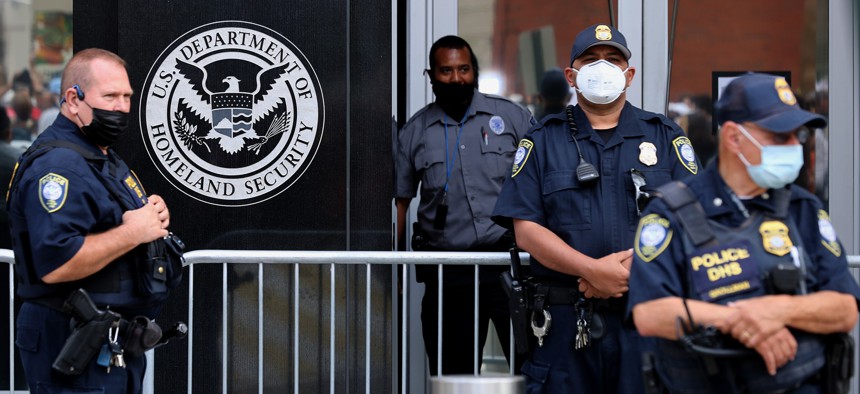
Security officers observe a protest outside ICE headquarters on September 21, 2021. Chip Somodevilla/Getty Images
ICE Has Assembled a 'Surveillance Dragnet' with Facial Recognition and Data, Report Says
Immigration and Customs Enforcement has used facial recognition to search through the driver's license photos of one in three adults in the U.S., according to a new report by Georgetown Law's Center on Privacy and Technology.
Immigration and Customs Enforcement, or ICE, "now operates as a domestic surveillance agency," according to a new report by Georgetown Law's Center on Privacy and Technology based on a two-year investigation.
The report details how, since the agency was established in post-9/11 legislation, ICE has moved beyond cooperating primarily with other law enforcement agencies to assemble an infrastructure that enables it to pull detailed information on Americans, immigrants and non-immigrants alike, with data from private data brokers and state and local governments.
ICE's "surveillance dragnet" also uses facial recognition, especially the scanning of driver's license photos for immigration enforcement, according to the report, which involved hundreds of Freedom of Information Act Requests and reviews of the agency's contracting and procurement records.
Between 2008 and 2021, ICE spent about $96 million on biometrics, a category that also includes fingerprinting and DNA testing, according to the report.
Currently, "there are few regulations limiting law enforcement's use of face recognition generally and almost no regulations addressing ICE's use of the technology," the report states.
ICE did not reply to a request for comment on the report from FCW.
The use of facial recognition dates to a 2008 contract between the agency and biometrics company L-1 Identity Solutions, which gave ICE access to the face recognition database of the Rhode Island motor vehicle department, according to the report, which details ICE's use of facial recognition searches of DMV databases.
ICE has used facial recognition tech to scan the drivers license photos of one in three adults in the U.S., and since 2015, the agency has requested face recognition scans of DMV databases in at least 14 states, according to the report.
"The use of face recognition on DMV data is particularly egregious because people don't expect to have their images and personal data be shared with other agencies. This is a betrayal of the trust that people put in their state agencies and needs to stop," said Allison McDonald, research fellow at the center and one of the report's authors, in a statement to FCW.
"This doesn't mean that other, less covert uses of face recognition are unproblematic. There is ample evidence that face recognition is unreliable and biased, and is not a technology that should be used by police or immigration authorities," she continued.
The report urges ICE to stop the use of facial recognition for immigration enforcement, pointing to concerns with race and gender bias in algorithms, the potential for misidentification and wrongful arrests and concerns about privacy and due process.
Since May 2020, ICE policy has prohibited the use of facial recognition tech in its Enforcement and Removal Operations, the report states, but not its Homeland Security Investigations.
ICE isn't the only agency to tap into facial recognition technology.
A 2021 report from the Government Accountability Office surveyed 24 agencies to find that most were using the technology for either domestic law enforcement, cybersecurity or physical security. The General Services Administration, for example, is currently considering the use of facial recognition for Login.gov.
The agency's surveillance work has occurred largely without judicial, legislative or public oversight, the report states. Most congressional leaders didn't know about ICE' use of facial recognition scans of DMV photos until media reports in 2019 – over a decade after the first known contract in 2008, the report states.
Another major source of information for the agency detailed by this investigation is data and algorithmic tools.
ICE has tapped into databases from private data brokers and state and local governments – often data given in order to get essential services, the report states, pointing to records from the Department of Motor Vehicles, as well as utility information, employment records and housing records.
In 16 states and the District of Columbia, for example, undocumented people can get drivers licenses. In six of those states, ICE has used facial recognition to scan driver's license photos; in five, it can look for driver's license information to use for civil immigration enforcement without a warrant.
The report also estimates that ICE can likely obtain address information for 74% of adults in the U.S. using utility records created when they tap into gas, electricity, phone or internet in a new home – information that can help trace people for deportation, the report states.
The sharing of data handed over to get essential services has already created evidence of a "chilling effect," or the deterrence of immigrants from interacting with government systems and enrolling in critical services, the report states.
The report does include recommendations, urging Congress to reform immigration laws, enact new data protections, update laws that limit the disclosure of information given by Americans to the DMV and conduct more oversight of ICE, including the agency's use of biometrics.
It also includes recommendations for state lawmakers on the use of water, gas, electricity, phone and internet records for immigraiton enforcement and ICE access to DMV data.







